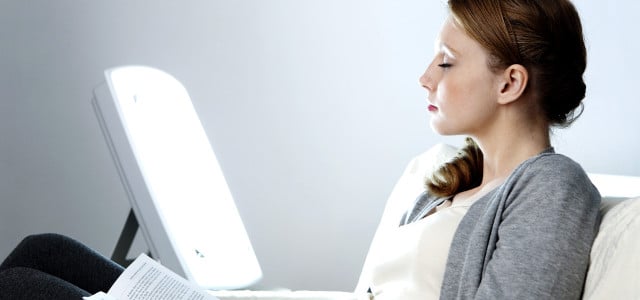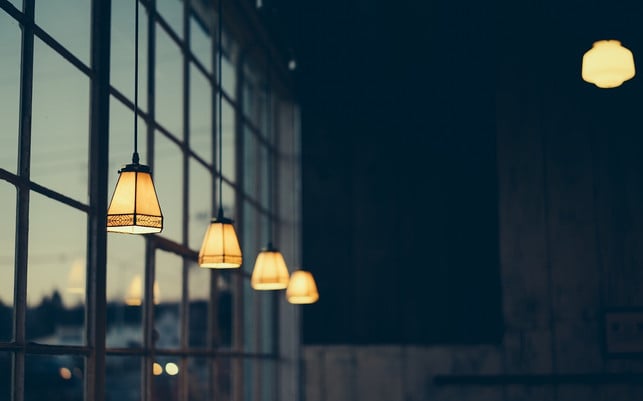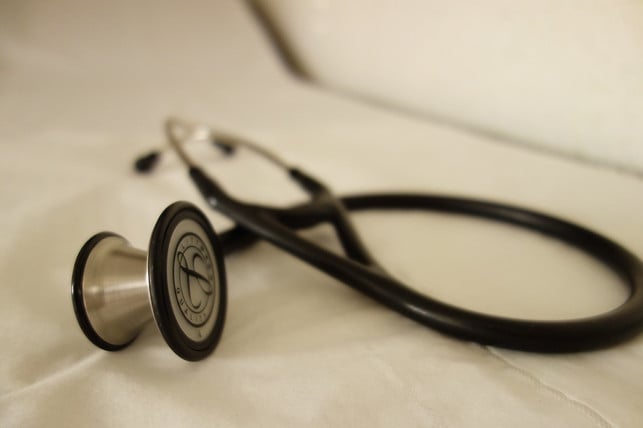
When the days are short in winter and the hours of sunshine are sparse, many people suffer from a bad mood and lack of motivation. Light therapy with a daylight lamp can often help to banish depressive moods.
Why light therapy?
Bad weather and shorter days – lack of light can lead to depressive moods or autumn depression or winter depression. It is important to counteract the lack of light during this time and get as much daylight as possible. But when the sun barely shows up, sometimes going for a walk isn’t enough. Then light therapy with a daylight lamp can help.
What is the use of the daylight lamp?

The lack of light in winter upsets the balance of melatonin and serotonin in our bodies. These two hormones control our internal clock.
Melatonin ensures that we can sleep and is released when there is a lack of light. Serotonin, on the other hand, helps us wake up in the morning and is released when there is light. Serotonin also acts as the body’s own antidepressant. In the dark winter months, a serotonin deficiency can quickly occur – we are tired, weak, listless and melancholic.
A daylight lamp stimulates the body to release more serotonin and produce less melatonin. Studies have shown that light therapy with daylight lamps can be very effective for depressive moods. In contrast to treatment with dietary supplements or medication, light therapy hardly causes any undesirable side effects.
Lumens, Lux, Kelvin and Watts
There are different units with which information is given for daylight lamps, but also for normal light bulbs. Here is an overview so that you can find your way around and understand what meaning the respective information has:
-
Lumen is the unit of luminous flux. In other words, it indicates how much light a lamp emits. The higher the value, the brighter the lamp is.
-
Lux is the illuminance. The value indicates how strongly an area is illuminated, usually the guideline value is 1 square meter.
-
Kelvin describes the color temperature. The lower the number, the warmer the light. The values for daylight lamps are around 5,500 Kelvin.
-
Watt The watt number indicates how much energy is required for the lamp or light bulb to light.
How daylight lamps work
Daylight lamps are lamps of different sizes, often organically shaped. Sometimes they look like a sculpture. For example, you can put it on your desk.
The lamps emit daylight over a large area. We speak of daylight because the light color emitted comes closest to our midday sun. A UV filter is built into the lamps so that only the healthy spectrum of daylight reaches our retina.
Important: A daylight lamp that is to be used for light therapy against depressive moods should have at least 2,500 lux to 10,000 lux.
Seek medical advice before using light therapy

Light therapy generally has a positive effect on the mood, even in people who do not have depressive moods. Before you decide on light therapy, you should clarify a few things:
Depressive moods can’t just be triggered by a lack of light. There are diseases that can be the cause. These include, among other things, an underactive thyroid, hypoglycemia, viral diseases or chronic fatigue. Light therapy with a daylight lamp will not help with these diseases. You should therefore seek medical advice in advance and make sure that your bad mood is not caused by one of these or any other illnesses.
In certain cases, light therapy should be used cautiously or not at all. This is especially true if you have existing eye diseases. There are also preparations such as St. John’s wort or psychotropic drugs whose effects are enhanced by light. Be sure to seek medical advice about this.
The correct use of the daylight lamp

A daylight lamp provides between 5,000 and 30,000 hours of light. With normal use it will last for many years. Light therapy is also about bringing the day-night rhythm back into balance.
From 10,000 lux, half an hour a day in front of the lamp is sufficient. If the lamp is not quite as bright, it should be more time. For most people, the best time for light therapy is morning.
Tip: Despite the recommendation, pay attention to your own rhythm and don’t force an artificial one on yourself. Find out which chronotype you are most likely to be. This might give you a better idea of when light therapy would best suit you during the day. That could also be in the evening. However, if you have trouble falling asleep afterwards, an earlier time is better.
You can have breakfast, read, work or simply meditate during daily light therapy. The only important thing is the following:
- Sit about half a meter in front of the screen and keep your eyes open.
- You don’t have to look at the lamp all the time, just turn to it every now and then.
Which daylight lamp to buy?

Unfortunately, there are currently no current tests from consumer institutes such as Stiftung Warentest on daylight lamps. In general, it is advisable to give preference to products with LED lamps and low energy consumption.
Some models from market leader Beurer seem to be particularly recommended (these models were recommended by the Süddeutsche Zeitung, Chip.de and Computer Bild, among others). They are available in different sizes, designs and features:
-
Beurer TL 50: The daylight lamp from Beurer is compact. It is suitable for the desk or office, for example. Its one-button operation makes it easy to use. Buy: from around 70 euros directly from Beurer, alternatively from Mediamarkt or Amazon. You can find an overview of all current Beurer models here.
-
GEO highlights other small models: including the Medisana LT 460 from around 50 euros, available at Shop Apotheke, Mediamarkt or Amazon. The most expensive model among the four winners at GEO is the Beurer TL 90 for around 160 euros, available directly from Beurer , alternatively from Otto or Amazon.
-
Particularly compact models: The Beurer TL20 daylight lamp looks like a white tablet with a stand. It is very thin, easy to take with you and currently only costs around 40 euros. You can get them from Saturn or Amazon. The Klarstein company offers a similarly compact model with the Summershine Slim. Available from around 40 euros at Otto, Wayfair or Amazon.
Are there any side effects of light therapy?
Side effects occur only very rarely with light therapy. If so, they are usually mild symptoms such as headaches, burning eyes, dry eyes and mucous membranes, reddened skin or irritability. These can occur especially at the beginning of light therapy. You can remedy the situation with small changes:
- shorter sessions
- different time of treatment
- Use of humidifiers
Then a daylight lamp is worthwhile

In winter, many people suffer from low moods and even depressive moods due to a lack of light. Light therapy with a daylight lamp can counteract the moods. Nevertheless, think carefully about whether you should buy a daylight lamp: Every additional electrical device is produced in an energy-intensive manner, uses energy during operation and sooner or later ends up in the trash as electronic waste.
However, if no other countermeasure works and the depressed mood returns every winter, a daylight lamp may be a good option for you.
Does the daylight lamp really work?
Experience has shown that with daily light therapy of around 20 to 45 minutes (depending on the brightness of the lamp), a positive effect occurs after just a few days. The mood is getting better. Light therapy reaches its full effect after about two weeks of regular use. Many people then feel lighter, more balanced and full of energy.
This effect is not a placebo. Studies have examined whether the effect is based solely on the belief in the positive effects of daylight lamps. This is not the case: the brighter lamps were almost always superior in their effect to the less bright ones.
Difference: daylight lamp and daylight bulb

You now know how daylight lamps work and whether they are really effective. But what about daylight bulbs?
The light bulbs do not have the same effect as daylight lamps. On the one hand, they are used like conventional light bulbs. This means that they are switched on much more often and usually for longer than daylight lamps. However, their lifespan is not as long as that of conventional light bulbs. On the other hand, daylight bulbs have neither an equivalent lumen nor lux value. They are called daylight bulbs because the Kelvin value is chosen so that the light color is similar to daylight and should therefore provide bright and clear lighting.
Read more on Techzle\.com:
- 11 foods to avoid in fall and winter
- Heating correctly: 15 tips to combat rising energy prices
- Mindfulness: The difficulty of being in the here and now
Revised by Lena Kirchner
** marked with ** or orange underlined Links to sources of supply are partly partner links: If you buy here, you are actively supporting Techzle\.com, because we then receive a small part of the sales proceeds. More info.